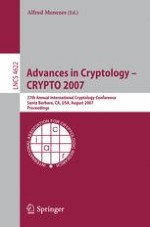2007 | Buch
Advances in Cryptology - CRYPTO 2007
27th Annual International Cryptology Conference, Santa Barbara, CA, USA, August 19-23, 2007. Proceedings
herausgegeben von: Alfred Menezes
Verlag: Springer Berlin Heidelberg
Buchreihe : Lecture Notes in Computer Science
